




| Home | Features | Club Nights | Underwater Pics | Feedback | Non-Celebrity Diver | Events | 8 August 2025 |
| Blog | Archive | Medical FAQs | Competitions | Travel Offers | The Crew | Contact Us | MDC | LDC |

|

|
 
 |
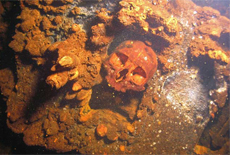 |
ISSUE 6 ARCHIVE - HYDRONAUTS MAKE US JEALOUS IN TRUK (CHUUK) LAGOONMay 7 - 19, 2008Andy YorkEver since I started diving, over a decade ago, it had been my dream to visit Truk Lagoon, and to dive the famous Japanese World War II shipwrecks sunk in 1944 in an American air attack called "Operation Hailstone". Now looking out of the window of the Boeing 737, I could finally see the beautiful, tiny tropical islands that were our destination, and on one of them Truk International airport. The runway didn't look too inviting, being rather short and surrounded on three sides by the sea, but with a final surge of thrust from the engines, and I suspect quite a lot of skill from the pilot, we avoided a crash landing and touched down on the runway. |
 |
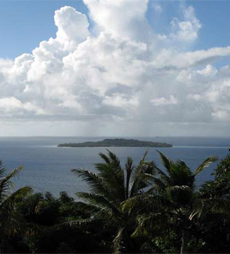 |
After a tortuous and tiring thirty-six hour journey and four
flights, via Kuala Lumpur, Manila and Guam, a group of ten
Hydronauts, with qualifications from advanced open water
diver to master scuba diver trainer, excitedly disembarked into
the tropical heat and humidity of Micronesia. This little known
island group is situated in the Pacific Ocean and consists of four
Federated States: Kosrae, Pohnpei, Yap, and Truk, or Chuuk as
it is more correctly known. Our introduction to Chuuk was the
slow and interminable queue at passport control, as everyone
got progressively hotter and more sweaty while waiting for
a large lady sitting in a shabby booth to call us forward, one
by one. Finally through, and with a hundred percent arrival
success rate of our checked baggage we could look forward
to a shower, a meal and a sleep at our hotel.
Staff from the Truk Stop Hotel, where we were booked for the first night, were waiting for their guests. Despite a mix up in the organisation we were soon boarding the buses and were treated to our first experience of the roads on Moen, the main island in Chuuk, and the sight of people going about their daily business. We passed worn concrete buildings with peeling paintwork and corrugated iron shacks, as well as some beautiful houses with colourful tropical flowers in the gardens, and were proudly shown the brand spanking new post office building. All the while the bus driver swerved and manoeuvred to avoid the huge potholes in the road and the oncoming traffic. We were welcomed at the Truk Stop and allocated rooms, including a Presidential Suite for Debra and I (it wasn't as good as it sounds), and all headed off to wash. Then, while some of the group slept, some explored the local shops, the dive shop and the bar, and the friendly manager hastily organised a tour of the main island. |
 |
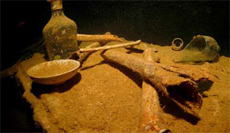 |
After sleeping, and a quick and welcome lunch we all headed
off for our tour. I had been promised a bus with air conditioning,
but perhaps unsurprisingly the AC didn't work, and this bus was
more like a sauna on wheels. It had clearly been raining and
now the driver had to avoid massive puddles as well as the
hazards from earlier in the day. The tour consisted of a visit to
St. Xavier High School, which was built by the Japanese for
a telecommunications centre during the war, and is constructed
from metre-thick concrete walls and 4 inch steel shutters.
Then it was onto a huge gun hidden in the rainforest, and to
the bullet-pocked lighthouse providing wonderful views over
Moen, the sea, and the other islands. Finally, we stopped at
the Japanese war memorial; it's important to remember that
this was the Japanese Empire's main base in the South Pacific
and the site of a huge bombing campaign by the USA.
A great introduction to Chuuk and its history.
|
 |
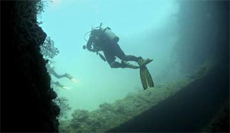 |
Next day, waking refreshed and ready to go, we got our
first sight of our home for the week. The S.S. Thorfinn came
steaming along, belching black smoke from her heavy
waste oil steam engines. The ship certainly does not conform
to the standard liveaboard specifications seen elsewhere
throughout the world, and that divers commonly encounter
in the Red Sea, but she has character in abundance.
Indeed it was the quirkiness of the ship that first attracted my
attention, as well as the amount of diving possible; 5 dives a
day, starting at 8am and finishing with a night dive at 8:30pm,
meaning up to 30 dives in one week. As we passed a group
of Russians disembarking the ship (including my ice diving
instructor from a previous holiday – what a small world!), we
all eagerly boarded and settled into the lounge. After finally
speaking to the skipper, Captain Lance Higgs, and the staff,
we acquainted ourselves with our large cabins. Then the
divemaster for the week (who I never saw in the water, let
alone near any dive kit!) organised us into two groups: the
testosterone fuelled males (Martyn, Graham, Dave, Will,
Steve and Kev) on the Port side, and the couples (Steve,
Sarah, Debra and myself) on the Starboard side. This meant
only 5 or 6 divers on each wreck at one time. The diving would
start at 2pm!!
|
|
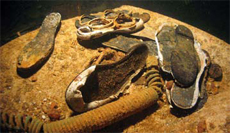 |
Starboard's first dive, with our dive guide Tomo, was the famous
Fujikawa Maru. Swinging into the water from the large rib that
speedily took us to our chosen wreck sites, I was welcomed
by a yelp from Steve. Looking down it was possible to see the
wreck below – and what a beautiful sight it was. Our first dive
on the Fujikawa was into the engine room and a quick visit
to the holds, but all too quickly it was time for the safety stop.
This wreck was so good we decided to dive it again later in
the week, this time to see the large gun, three Zero fighter
aircraft, gas masks, shoes and some rifles (they are much
heavier than Tomo made them appear, much to my flailing
embarrassment).
|
 |
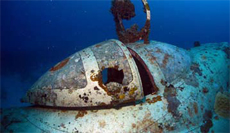 |
Our second dive was on the Kansho Maru. Again Tomo,
who from now on would be nicknamed the 'ferret', took us
down, down, down stairways into the darkness of the engine
room, but this time we also saw the first of the many black tip
sharks and spotted eagle rays we would encounter during
the week. On a second dive later in the week, we had a very
close encounter with a spotted eagle ray, only 5m away,
and also saw the anchor perched on the main deck and
the stern gun.
|
|
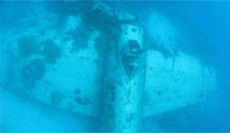 |
During the week we dived a number of the main
wrecks of Truk lagoon, and most of them are unique
in some way.
Unkai Maru Or the Hollywood dive. Ask any child to draw the underwater world, and there will be fish, a coral garden, a wreck, some divers, and a shark. Add some napoleon wrasse and some dolphins on the rib journey back to Thorfinn, and the picture is complete. |
|
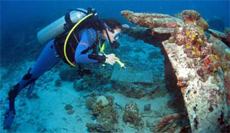 |
Hoki Maru John Deere diggers and a half-track vehicle. Shinkoku Maru Or the aquarium as I called it; – so many fish! At one point I had to wave some out of the way or I would have missed a black tip shark only metres away. Sankisan Maru Rifle shells, detonators, and tons of fish on the masts and kingposts for a very enjoyable safety stop. |
 |
|
Yamigiri Maru The engine room, a skull to remind us of the reason these wrecks are here, and shells reputed to be for the famous Yamato battleship's 18 inch guns (apparently a tall tale). Seiko Maru Covered in beautiful corals at 40m! Also an open bridge which was once roofed in wood, a gun on the bow, and lovely fan corals adorning the front of the bridge. Gosei Maru Only 3m at its shallowest, and a lovely atmospheric dive. Saw three crown-of-thorns starfish here, on top of the many we had seen on other wrecks. Rio de Janeiro Maru Converted passenger ship with a very interesting engine room, and lots of sake bottles (the Japanese in Truk must have been drunk for most of the war). Heian Maru Another converted passenger ship used as a submarine tender, with the name clearly readable on the ship's bow. It's full of precariously perched torpedos, and submarine periscopes, as well as bric-a-brac, such as fixed mount binoculars, a telephone and more sake bottles. The engine room was also interesting, and thankfully we managed to extricate Steve when he got stuck on a pipe in a narrow section at the back of the line. Kiyosumi Maru A bicycle, and more sake bottles! |
||
|
And then there was my favourite wreck dive, and the
worst wreck dive. Let's start with the Kikukawa Maru,
or the "upturned rusty bucket". When Tomo asked "where
to?", I should have twigged when I saw his face. Why
would anyone dive this unless they are either very
interested in the history of a frankly boring lump of metal,
or are interested in the two or three diesel and radial
engines inside? Or are completely mad? Surrounded
by the best wrecks in the world, here we were at 30m,
needing to descend further to get inside. It was after
this dive we realised the divemaster, who was setting
our dive schedule every day, hadn't dived most of
the wrecks!
Now for my favourite. We dived the S.S. Nippo Maru twice in the week. At 33–38m to the deck it was a relatively deep dive, but even at 30m there was plenty to see, including explosive fuses, a gas mask and cutlery. Starting over a truck frame and then moving to a tiny Ha-Go tank. Then up past anti-aircraft guns, to a lovely bridge area and over to see the U.S. Howitzers sitting on the deck. A very interesting dive that summed up Truk Lagoon for me. And even better, both times we dived this wreck we saw sharks and eagle rays. And it's not just shipwrecks. Two very interesting dives are the wrecks of two aircraft, the Betty Bomber and the Emily flying boat. And for those who have had enough of wrecks, our last dive of the week was at Shark City. In my experience, anywhere called shark anything is usually totally devoid of sharks, but this was different. Admittedly this dive was a bit of a circus, but on entering the water we were almost immediately met by three sharks circling their way up to meet us. The 'ferret' positioned some black bags under some stones on the bottom, and then beckoned us to come closer to the action. At least twenty grey reef and black tip sharks then violently tucked into the tuna contents of the bags, and each other if necessary. All too quickly our computers were telling us it was time to ascend, and 15 minutes of sharky safety stop later we were back on the rib. With the week's fantastic diving over, our last evening on Thorfinn was spent being treated to a barbeque feast, and some local dancing by the beautiful girls who'd been our hosts. How do they gyrate and move their hips like that? We also got some dance lessons, as the beer and whisky started to take effect. After a last day drying smelly kit, packing, and t-shirt shopping back at Truk Stop, we returned to the airport with the news that a cargo plane had overshot the runway at a neighbouring island group in Micronesia. News that wasn't particularly surprising to any of us. Getting through passport control was a breeze. We were even given a Continental Micronesia Airlines iced biscuit in the shape of a toy aircraft as a goodbye gift; you don't get that at Heathrow airport. And then we were taking off, leaving the wonderful people and sights of Chuuk behind, and heading for a one night stopover in Manila (via Guam). |
 | |
|
At the luxurious Dusit Hotel Nikko in Manila we treated ourselves
to well deserved beer and cocktails, a lovely big bed, and
then a quick city tour the next day with our unplanned host,
Georgie Porgie, who accosted us at the citadel, and then very
entertainingly highlighted the sights of the Intramuros old town
(somehow this included a piano rendition of some Beatles
songs!) Finally, passing multitudes of decorated jeepneys,
we were back at Manila airport for our final two flights back
to London.
Captain Lance, the guides Tomo and Paco, the chef and the staff of the Thorfinn are gratefully thanked for providing us with an excellent holiday, interesting stories, good food, smiling faces, and lots of fantastic, fun and safe diving. Before heading off to Truk Lagoon, I was worried that my high expectations would not be matched. But matched they were, and even surpassed. The quality of the wrecks I had expected, but not the amount of fish life present. Most of the wrecks are still in excellent condition, and sit well within the limits available for recreational divers. Though some of the wrecks are very deep, in accordance with common knowledge, some of our group were able to spend the whole week in the 30m range, and did not miss out on any of the dives. Despite the depth the diving is relatively easy as long as buoyancy is good, with little current, warm (28–30°C) and clear blue water. The most hardcore divers in our group managed 25 dives in the week, but none of us were able to fit in the most famous wreck in the lagoon, the San Francisco Maru. Maybe we need to come back sometime. Any takers? Nearest recompression chamber Hyperbaric Medicine Unit, 2214 Route 16, Harmon, Guam Tel: +1 671 647 2555 |
 | |
Previous article « Club Night Next article » Drugs 'n' Diving Back to Issue 6 Index | ||